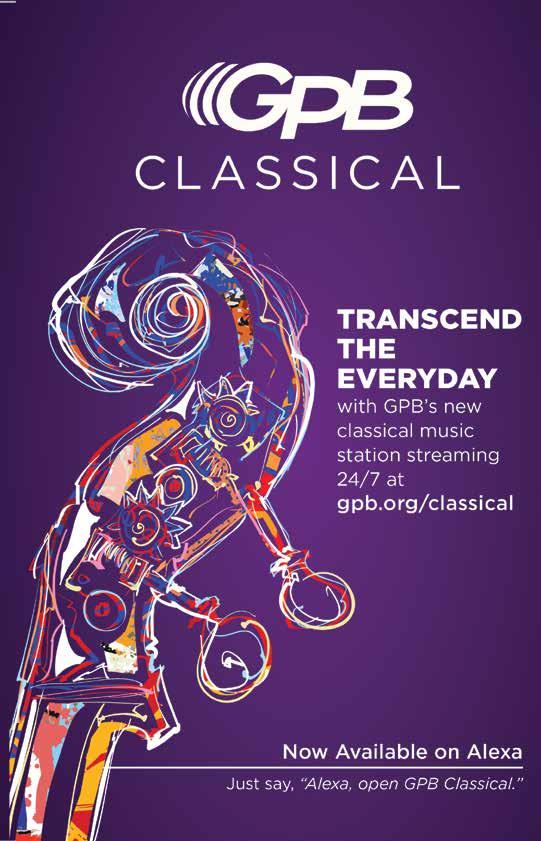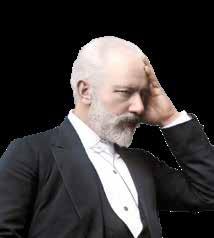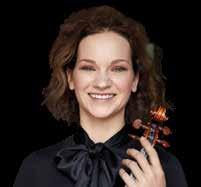
9 minute read
DECEMBER 1, 3
Concerts of Thursday, December 1, 2022, 8:00pm Saturday, December 3, 2022, 8:00pm
ELIM CHAN, conductor
HILARY HAHN, violin PYOTR ILYICH TCHAIKOVSKY (1840–1893) Violin Concerto in D Major, Op. 35 (1878) 36 MINS
I. Allegro moderato
II. Canzonetta: Andante (attacca)
III. Finale: Allegro vivacissimo Hilary Hahn, violin INTERMISSION 20 MINS
DMITRI SHOSTAKOVICH (1906–1975) Symphony No. 10 in E Minor, Op. 93 (1953) 56 MINS
I. Moderato
II. Allegro
III. Allegretto
IV. Andante — Allegro
This weekend’s concerts are dedicated to SHEILA L. & JONATHAN J. DAVIES in honor of their extraordinary support of the 2021/22 Annual Fund.
The use of cameras or recording devices during the concert is strictly prohibited. Please be kind to those around you and silence your mobile phone and other hand-held devices.

by Noel Morris
Program Annotator
Violin Concerto in D Major, Op. 35
In addition to the solo violin, this concerto is scored for First ASO Performance: two flutes, two oboes, two clarinets, two bassoons, four January 25, 1948 horns, two trumpets, timpani and strings. Robert Harrison, violin “I went one evening to my future wife and told her frankly that I could not love her, but that I would Henry Sopkin, conductor Most Recent be a devoted and grateful friend.” Thus, Pyotr Ilyich ASO Performances: Tchaikovsky got engaged. At the time, he believed his October 21–24, 2021 bride, Antonina Milyukova, could make his life “peaceful Juanjo Mena, conductor and happy.” She didn’t. Midori, violin Just six months before, he had been in love with Josef Kotek, a violin student at the Moscow Conservatory. “My only need,” wrote Tchaikovsky, “is for him to know that I love him endlessly.” Although there has been enormous speculation about Tchaikovsky’s motives for marrying, the only thing we know for sure is that it was not for love. While Antonina claimed to have loved him from afar, they barely knew each other. They married on July 18, 1877, before a handful of witnesses that included his (likely) former lover Josef Kotek. By August 8, Tchaikovsky desperately needed to get away from her. “I leave in an hour’s time,” he wrote. “A few days longer, and I swear I should have gone mad.” And he wasn’t exaggerating. In less than three weeks he had descended into a deep depression and found himself utterly unable to work. After spending the rest of the summer with his sister, he returned to his bride for just two weeks in the fall before deciding the marriage was unworkable. At the same time, he developed an intense bond with another woman. Kotek had been working for a wealthy, rather reclusive widow named Nadezhda von Meck. She shared Kotek’s interest in Tchaikovsky’s music. Before long, she and the composer became pen pals. Taking special care never to meet face-to-face, the two of them developed a deeply personal and gratifying friendship. She became his muse and benefactress (and a great source of letters for future music historians). In 1878, still reeling from his failed marriage, Tchaikovsky took an extended trip with his brother to Europe. Gradually, he started writing music again and his mood brightened. In Clarens, Switzerland, they enjoyed the use of von Meck’s villa and called on Kotek to join them

WIKIMEDIA
there. Perched on the shores of Lake Geneva, Kotek and Tchaikovsky shared musical evenings together. It was a reading of Eduard Lalo’s Symphonie espagnole, with Kotek on violin and Tchaikovsky at the piano, that lit the fire for a new violin concerto. Sketching the piece in just eleven days, Tchaikovsky worked through the solo passages with the help of Kotek and dedicated the concerto to the famous Hungarian violinist Leopold Auer. This proved to be a major disappointment for the composer; Auer took one look at the piece and refused to play it. Two years passed before the Russian violinist Adolph Brodsky took up the concerto in Vienna and gave its world premiere, which prompted a scathing review from the famous music critic Eduard Hanslick. “Tchaikovsky’s Violin Concerto gives us for the first time the hideous notion that there can be music that stinks to the ear,” he wrote. And the fragile Tchaikovsky hung on every word of it, committing the entire thing to memory. As the years went by, it seems that Auer grew to regret his early judgment of the Tchaikovsky Violin Concerto. Stumbling over various explanations, he claimed he had thought the piece needed work or that he had doubted its intrinsic worth before saying in 1912: “The concerto has made its way in the world. And that is the most important thing.” Indeed. Today, Auer is best remembered, not for his playing, but for the violinists he taught, including Nathan Milstein, Efram Zimbalist, Mischa Ehlman and Jascha Heifetz—all major artists who helped propel the Tchaikovsky Violin Concerto into a concert-hall favorite.
Symphony No. 10 in E Minor, Op. 93
Symphony No. 10 is scored for piccolo, two flutes (one doubling piccolo), three oboes (one doubling English horn), three clarinets (one doubling E-flat clarinet), three bassoons (one doubling contrabassoon), four horns, three trumpets, three trombones, tuba, timpani, percussion and strings.
First ASO performances: November 29–December 1, 1979 Hiroyuki Iwaki, conductor
Most recent ASO performances: January 12–14, 2017 Donald Runnicles, conductor
It’s difficult to talk about Shostakovich without acknowledging the trauma he suffered under the thumb of Joseph Stalin. In January of 1936, his hit opera Lady Macbeth of the Mtsensk District was running in three separate productions in Moscow alone when Stalin walked out mid-performance. Official censure followed, and Shostakovich was labeled an enemy of the people. Overnight, his music was canceled. People crossed the street to avoid speaking to him, and his income dropped percent. Known to history as the Great Purge or the Great Terror (1936–1938), this was a time when scientists, educators, entertainers, politicians, landowners and members of the Red Army vanished in the night. The meaning of the composer’s rebuke was unambiguous—he had a brush with death.
The Tenth Symphony came along 17 years after the 1936 ordeal. In the intervening years, the composer clawed his way back into good standing with the apparatchiks. He avoided offering anything that outwardly violated Party dictates (today’s musicians detect great irony that suggests veiled dissent in his works). To be safe, he stowed his riskier compositions in a drawer. Through the duration of World War II, Stalin was too distracted by Hitler’s army to wage war on his people. (For 900 days, German soldiers laid siege to Leningrad.) At war’s end, Soviet authorities expected Shostakovich to write an epic symphony to mark their victory, something to glorify Stalin and Soviet life. Instead, he produced a lean, puckish piece that caused much head-scratching among the war-weary Soviets. It took a while for his critics to act, but in 1948, the Committee of Artistic Affairs banned a number of Shostakovich’s works, including the Ninth Symphony, and summoned him to make a public apology for having written music deemed “anti-people.” Shostakovich lost his job at the Moscow Conservatory and again began a process of “rehabilitation,” writing music that would satisfy the authorities. For the next five years, he declined to issue another symphony until Joseph Stalin died in March of 1953. Like many things about the Shostakovich biography (he lived in a time when truth and lies got people killed), there are conflicting accounts about the composition of the Tenth Symphony. His friend and confidante Tatyana Nikolayeva insisted that he began the piece in 1951. Shostakovich said he wrote the piece (or the bulk of it) in the summer and fall of 1953. “I wrote it right after Stalin’s death, and no one has yet guessed what the Symphony is about,” said the composer (purportedly). “It’s about Stalin and the Stalin years.” That quote comes from the Shostakovich memoir titled Testimony, published in 1979 by Solomon Volkov. It must be said, the legitimacy of this document has been hotly debated, with people close to the composer arguing on both sides. But for many musicians, it’s difficult to separate the composer’s life experience from the fabric of the Tenth Symphony. The piece contains (at least) two musical monograms: the first is based on the German spelling of his name, Schostakovich, to spell D-S-C-H (“S” is the German name for E flat; “H” is the German name for B natural.) The second is based on the name of a favorite student, Elmira Nazirova. For this, he combined musical notes with solfège to spell E-La-Mi-Re-A. This theme sounds as a horn call in the third movement. Shostakovich continues to use his monogram, D-S-C-H, until the very end of the symphony when the low brass blares these notes. It sounds brazen and defiant. Could this be the composer’s rebuke of Joseph Stalin? Possibly. It’s nice to think that it is.
WIKIMEDIA
RAHI REZVANI

DANA VAN LEEUWEN ELIM CHAN, CONDUCTOR
One of the most sought-after of the young conductors, Elim Chan became the first female winner of Donatella Flick Conducting Competition and has been appointed Chief Conductor of the Antwerp Symphony Orchestra from the season 2019/20. In addition, she also holds the position as Principal Guest Conductor of the Royal Scottish National Orchestra since 2018/19. The 2021/22 season saw an appearance at the Edinburgh International Festival followed by debuts with the Sinfonieorchester Basel as well as Boston and St. Louis Symphony orchestras, European Union Youth Orchestra, Mahler Chamber Orchestra, Swedish Radio Symphony
Orchestra and ORF Radio-Symphonieorchester Wien. Further to that, Elim Chan will return to orchestras with whom she is closely connected, amongst them Philharmonia Orchestra, Los Angeles Philharmonic and Gürzenich Orchester Cologne. Elim Chan became Assistant Conductor of the London Symphony Orchestra in 2015/16 and was appointed to the Dudamel Fellowship program with the Los Angeles Philharmonic the following season. HILARY HAHN, VIOLIN
Three-time Grammy Award-winning violinist Hilary Hahn melds expressive musicality and technical expertise with a diverse repertoire guided by artistic curiosity. Hahn is a prolific recording artist whose 21 feature albums on Decca, Deutsche Grammophon, and Sony have all opened in the top ten of the Billboard charts. Three of Hahn’s albums—her 2003 Brahms and Stravinsky concerto disc, a 2008 pairing of the Schoenberg and Sibelius concerti, and her 2013 recording of "In 27 Pieces: the Hilary Hahn Encores"—have been awarded Grammys. Jennifer Higdon’s
Violin Concerto, written for Hahn and which she recorded along with the Tchaikovsky concerto, went on to win the Pulitzer Prize. As Virtual Artist-in-Residence with the Philharmonic Society of Orange County, Hahn performed three programs this season, including the world premiere of her newly composed cadenza to Mozart’s Violin Concerto No. 5. Hahn has also taken time this season to perform the Dvořák Violin Concerto, appearing with both the Orchestre Philharmonique de Radio France and Frankfurt Radio Symphony Orchestra. In March 2021, Deutsche Grammophon released Hahn’s 21st album, "Paris", recorded with Mikko Franck and the Orchestre Philharmonique de Radio France.










